The concept of successful and independent aging has become increasingly important, while senior citizens dominate the population. An active independent engagement in life through participation in social and productive activities is a very important aspect of successful aging. However, the built environment oftentimes directly interferes with the successful engagements of older adults once their individual needs change. Therefore, it is necessary to provide modified living environments designed to suit the needs of aging adults. This is the essence of the Aging in Place market of today.
What can be done to solve this inevitable housing dilemma facing the growing number of aging Americans? Of all the design theories that attempt to accommodate the aging process, Universal Design is the most desirable option as it provides built environments that benefit everyone, regardless of their age, size, or ability. Universal Design is a promising voluntary philosophy that requires increased attention from designers and builders participating in Aging in Place. Taken as a whole, it is evident that the application of Universal Design to the home environment is a positive step toward successful aging and living for anyone. In fact, the principles of Universal Design segues directly into what is required for Aging in Place.
A Wheelchair Accessible Kitchen Incorporating Universal Design Principles
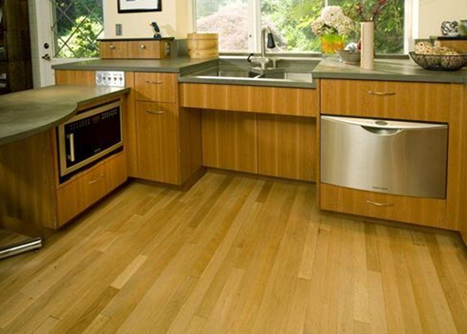
Our existing architecture does not lend itself well to accomplishing any simple Aging in Place home remodels. In fact, there are more inaccessible homes in all of the US than there are accessible homes and 45% of these existing traditional homes are owned by baby boomers. What is more, the baby boomer group represents the largest and oldest group of homeowners. This particular aging group desires to live in their existing home around familiar surroundings as they Age in Place. But what if, for some reason, a home that was once sufficient for all family members becomes no longer accessible. This involves the need for a certified CAPS professional.
Unfortunately, in most traditional residential US properties, there are commonly no easy ways to enter the home proceeding into bathrooms or utilizing kitchens without coming into contact with one architectural barrier or another-especially if a wheelchair or walker is being used to help with mobility issues. While an estimated 80% of aging homeowners have a firm plan to Age in Place, every mobility device requires the proper clearance and distance along a customized accessible route within the home to function properly. This comfortable route is identified during wheelchair remodeling projects.

The National Association of Home Builders, in partnership with the AARP and Home Innovation Research Labs, created the CAPS program, which includes training and education on the technical, business management and customer service skills essential to compete in the fastest growing segment of the residential remodeling industry--home modifications for aging in place. David L. Traut, CAPS the President and owner of T-Square Company in Austin, Texas is one of the select group of professionals nationwide to earn the Certified Aging-In-Place Specialist (CAPS) designation, identifying him as a home remodeler and builder with the skills and knowledge necessary to remodel or modify a home to meet the unique needs of the older population, disabled owners, or their visitors. T-Square Company offers complete services concerning disability renovations beginning with their design/build philosophy. Furthermore, David is certified in Universal Design in the United States and Australia. Call them today at 512-444-0097 to set up a professional assessment of your living situation.

After over a year of writing to fulfill his customers' requests, David's new book, "Age in Place At Home," is available for purchase from Amazon. Go to the link below to order his knowledgeable paperback book, which was released in late November, 2022. It provides a great guideline for using the principles of Universal Design in new home construction and/or remodeling for every room in your home. Get your copy today.
https://www.amazon.com/gp/r.html?C=2Z24ENUUAEWUK&K=13Y7YU7PKKYAC&M=urn:rtn:msg:20221010201802eb9acb7b24004a4785cd2ec1d4f0p0na&R=3R6MK9WDXJPH7&T=C&U=http%3A%2F%2Fwww.amazon.com%2Fdp%2FB0BHTV28RV%3Fref_%3Dpe_3052080_276849420&H=7FWEPMGCH0TT8LN6SKPMUOCVJNYA&ref_=pe_3052080_276849420
Tags:
wheelchair accessible remodeling,
ADA remodeling,
ADA compliance,
Austin Accessibility Design,
Austin accessible home remodeling,
senior aging in place services,
universal design building for a lifetime,
what is universal design,
universal principles of design,
Austin Senior Home Remodeling,
senior home modifications in Austin,
Austin disability contractors for special needs,
Austin aging in place specialist,
veterans home accessibility help in Austin, Texas,
what is aging in place,
wheelchair accessible homes,
Austin home accessibility solutions,
ADA Accessibility,
home accessibility services,
forever home,
sustainable living design
Suppose the current pandemic taught us anything concerning safety and institutional living situations. In that case, we now know it is much safer to remain in a barrier-free home surrounded by familiar surroundings and friends. During the stay-at-home mandates, everyone knew what Aging in Place meant because all family members lived within this inspirational and needed solution. We all became better acquainted with our homes and family members. The best way to approach a desire to Age in Place is by being proactive before an illness takes control of your life. At that point, you must deal with it reactively. There are many differences between home modifications and a home remodel. The main difference is home modifications involve investing in your familiar home versus spending during remodeling. Home modifications enhance your ADL (Activities of Daily Living), whereas remodeling deals more with aesthetics. An example of a home modification increasing accessibility includes a walk-in tub with easy access versus an aesthetically pleasing deep soaking tub. Investing in your home using the principles of Universal Design will benefit your future retirement years by making your home gradually conform to your needs. The point of involving this universal technique in periodic remodels within your home is that the alterations appear invisible until their advantages are needed when your housing needs change. A professional CAPS program graduate performs accepted home modifications to increase accessibility for any resident.
What are CAPS services, and what does CAPS stand for? Let's be clear, it has nothing to do with hats or the associated industry. First of all, CAPS stands for Certified Aging in Place Specialist. The aging societal changes and inventory of inaccessible existing houses created the need for a CAPS certification program. This designation program, offered through the National Association of Home Builders, NAHB, in collaboration with The American Association of Retired Persons AARP, incorporates components of assessment, technical knowledge, and management skills related to proven home modifications used to help people stay at home safely and independently for a more extended time. The program was developed in 2001. The CAPS program connects responsible professionals with homeowners needing specialized accessibility services ever-increasingly. Professional CAPS services include home assessments, consultations, accessible designs, complete build-outs, accessible additions, and determining a positive path forward for any individual or their visitors requiring better accessibility and usage of their existing home, better fitting their personal needs.
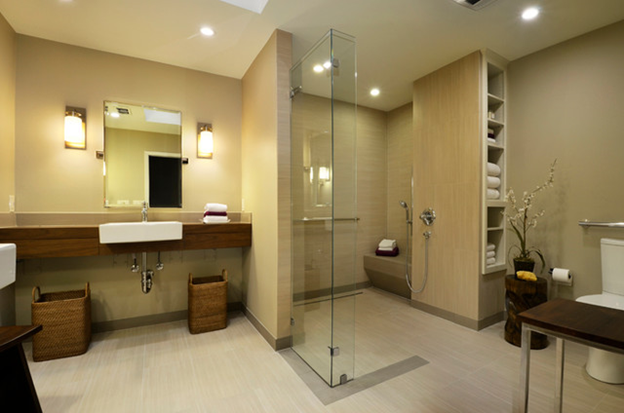
The CAPS services offered by a CAPS professional vary from a complete accessible remodel beginning at the curb and ending inside the backyard. Additionally, you can improve the comfort of the most used rooms in the home, like bathrooms, kitchens, and family rooms. The detailed process begins with a home assessment. The precise modifications identified increase usability according to the homeowner's and family's personal needs. The housing modifications are designed for all generations within a home, from children to older adults. Ordinary homeowners with extraordinary challenges partner up with experienced CAPS professionals and their own families. Working as a team, the trained CAPS specialist and any family caretakers or therapists identify the day-to-day problems weighing on those with health limitations. Aging in Place services provided by a specialized remodeling contractor ensures all accessibility issues of the home are accomplished correctly. T-Square Company, located in SW Austin, Texas, is one of the specialized CAPS certified contractors.
The CAPS credential is a nationwide initiative, and many building and design professionals are taking advantage of the helpful training nationwide. David L. Traut, president, and owner of T-Square Company, is an active CAPS member (#1636580) and has participated in the program for over a decade. Furthermore, he has actively completed accessibility design/build remodels for over three decades for the private sector, HUD, and the VA. Always check a person's credentials to verify the remodeler holds an active CAPS certification and is familiar with Universal Design. All registered CAPS program graduates and remodeling companies are listed in a national registry in Washington, DC. The information is found by calling 1-800-368-5242 or simply visiting their website at: http:www.nahb.org/en/learn/designations/certified-aging-in-place-specialist.aspx.

T-Square Company in SW Austin, Texas, located at 14141 Highway 290 West, Suite 800, is a CAPS-certified remodeler and offers design/build Aging in Place projects using principles of Universal Design. Call 512-444-0097 to discuss your project today and learn how to achieve better accessibility within your existing home. Our knowledge and experience can help solve your personal needs within your existing home. Whether you need a safer shower, wider doorways, a zero-step entrance, or a more accessible kitchen to entertain your family and friends, T-Square Company is here to help.
Tags:
barrier free access,
aging in place remodeling,
CAPS,
aging in place home modifications,
ADA compliance,
custom tub to shower conversions,
accessible home remodeling,
CAPS remodeling techniques,
aging in place services,
bathroom modifications for disabled,
ADA bathroom Austin, Texas,
home modifications for independent living Austin,
Austin Handicap Remodeling,
universal design ideas,
certified aging in place consultant in Austin,
universal design remodeling contractor,
handicap accessible remodeling,
barrier free remodeling,
disability remodeling,
handicap accessible bathroom shower,
veterans home remodeling in Austin, Texas,
veterans home accessibility help in Austin, Texas,
accessible toilets,
ADA Compliant grab bars,
home access,
what is aging in place,
accessible home builder in Austin,
ADA Compliant Bathroom Vanity,
the basics of aging in place,
universal design home additions,
CAPS-certified remodeling in Dripping Springs,
Dripping Springs home accessibility solutions,
Dripping Springs kitchen remodel,
Dripping Springs bathroom remodel,
Dripping Springs TX home modification services,
Dripping Springs home modification services,
Dripping Springs bath remodeling,
Dripping Springs senior home remodeling,
Dripping Springs special needs contractor,
Dripping Springs aging in place specialist
Disability is a complex phenomenon representing an interaction between one's physical impairments, the activities one needs to perform, and the architectural barriers within the space in which this situation occurs. Disability is not an age-related condition. The terminology and jargon used for disabilities evolve regularly, whereas "handicapped" is not widely accepted. Disability is no longer merely a description of intellectual or physical impairments. Each individual with similar impairments describes his or her limitations differently. The blind don't experience their world the same as a person with deafness. Some of our societal statistics that weigh into Aging in Place situations include reports stating that 19% of the population between the ages of 16 and 64 and 42% of those of us 65 and over have a physical disability affecting the activities of their daily lives. Aging in Place home remodeling in Dripping Springs for a progressive condition comes into play. This is the only way to ensure safety and mobility for the homeowner or family member requiring the home modifications. The two main groups driving elder construction and the Aging in Place market are those people who are 65 and over and the baby boomers. The first group reached 55 million in 2020. The baby boomer generation born between 1946 and 1965 today makes up 28% of the U.S. population and some 77 million people. The published guidelines for ADA accessibility for buildings and facilities are an excellent resource for ideas on making a home safer and easier to live in. Many of these published guidelines, particularly requirements for corridor and door widths, safety bars, and proper access to different facilities, can go a long way in extending the amount of time an elderly or physically impaired individual can live independently.

The situation holds for a disabled child, only on a smaller but changing scale. It is estimated that 5.4 percent of children five to seven years old are disabled representing a considerably large portion of the population. Sometimes, the living environment must be changed to impact the child's life significantly. Making your home accessible for a special-needs child will give your entire family a feeling of security and freedom. Your child with the disability will become more comfortable and be able to maneuver through and use the home more safely. They will be able to develop the life skills they need in their daily environment rather than just focusing on treatment. Fortunately, whatever is needed in the way of home modifications to create a safe and comfortable environment for your child is available through the registered and certified CAPS program. Accessibility should be a concern no matter what your age. If your concerns are not for you, barring any life-changing accident, they could concern the accessibility of another generation's independence in using the bathroom. Furthermore, today's multigenerational households exhibit accessibility issues affecting three to six generations, all of which must be addressed. CAPS professionals in the remodeling industry can help solve these issues while performing design/build home modifications.
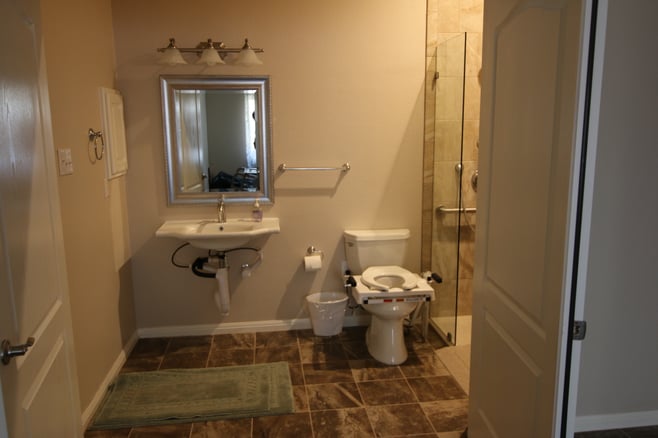
Modifications of existing homes are necessary because people aged 50 and older want to remain in their current homes for as long as possible. This desire is known as Aging in Place. Aging in Place home modifications in Dripping Springs should only be undertaken by a CAPS-certified remodeling company. This is the only way you can be assured that the home modifications are the right choices to satisfy your needs. There is no need to waste money only to discover that an inexperienced and unqualified remodeling company did the wrong alterations. Indeed, a trained CAPS professional and remodeling contractor with years of experience will cost you more than a handyman illegally playing among the trades at your peril. Still, then again, there are those professional guarantees to consider. The professional versus the handyman is more likely to seek your overall satisfaction that will follow him into his next job. An actual building professional can also orchestrate the job's smooth flow limiting the downtime of a most functional room. Always check their credentials to verify that the remodeler holds a CAPS certification. All registered CAPS program graduates and their remodeling companies will be listed in a national registry in Washington. The information can be found by simply visiting nahb.org/CAPS.

Being proactive and preparing for one of those highly likely events involving someone in your home needing room modifications for even a short time while recovering from surgery is undoubtedly an intelligent move. The new evolving concept known as Universal Design for home remodeling is catching on nationwide and has been a sign of the times for several years. These new home remodeling advances keep the living environments safer and will not compromise the home's aesthetics or resale value. Exhibiting Universal Design principles in a building makes a home more accessible to all regardless of their mobility or adaptive abilities and at any age. The evolution of new universal products used in room modifications making homes more accessible has come about in the remodeling industry. Homes can become more accessible to people as they age. Universal Design interior modifications include adding grab bars or handrails throughout the home, lowering upper cabinets and countertops, adding non-slip flooring, widening hallways, or installing stair lifts and wider doors. You might also consider lowering light switches and thermostats and installing easier-to-use door levers. Universally, you should try to provide a clear barrier-free path or accessible route to the most visited areas of your home.

David L. Traut, CAPS (#1636580), the owner and president of T-Square Company in SE Austin, is one of the select group of professionals nationwide to earn the Certified Aging-In-Place Specialist (CAPS) designation, identifying him as a home remodeler and builder with the skills and knowledge necessary to remodel or modify a home to meet the unique needs of the older population, disabled owners, or their visitors. We are a registered contractor with the VA to help our veterans. For more information about T-Square Company, visit www.tsquareco.com or call 512-444-0097.

Tags:
ADA compliant kitchen cabinets,
aging in place remodeling,
CAPS,
aging in place home modifications,
aging in place,
aging in place home improvements in Austin,
wheelchair accessible remodeling,
wheelchair accessible baths and kitchens,
handicap home modifications,
CAPS certification,
custom tub to shower conversions,
wheelchair accessible baths,
CAPS professional in Austin,
CAPS certification holder in Austin,
accessible home remodeling,
CAPS remodeling techniques,
Universal Design,,
disability home remodeling in Austin,
home modifications for independent living,
aging in place specialist,
aging in place services,
aging in place design,,
elder construction,
certified aging in place specialist,
handicap remodeling contractors in Austin,
Austin elder construction,
bathroom remodeling contractor Austin Texas,
remodel bathroom for handicap Austin Texas,
handicap home modifications for disabled,
handicap accessibility,
home modifications Austin, Texas,
accessibility remodelers in Austin,
roll in showers,
roll in showers in Austin,
home modifications for independent living Austin,
certified aging in place consultant in Austin,
home modifications for children with disabilities,
aging in place home remodeling,
home accessibility help in Austin,
home remodeling for seniors Austin,
disability contractor in Austin,
special needs contractor in Austin,
disability and special needs contractor Austin,
veterans home accessibility help in Austin, Texas,
disability renovation services in Austin Texas,
Dripping Springs home accessibility solutions,
Dripping Springs kitchen remodel,
Dripping Springs bathroom remodel,
Dripping Springs TX home modification services,
Dripping Springs home modification services,
Dripping Springs bath remodeling,
Dripping Springs bath remodel,
disability and special needs in dripping springs,
disability home remodeling in dripping springs,
Dripping Springs senior home remodeling,
dripping springs handicap bathroom contractor,
Dripping Springs special needs contractor,
Dripping Springs aging in place specialist,
disability bathroom remodeling in Dripping Springs
What are CAPS services and what does CAPS stand for? First of all, CAPS stands for Certified Aging in Place Specialist. The aging societal changes and inventory of inaccessible existing houses created the need for a CAPS certification program. This designation program, offered through the National Association of Home Builders, NAHB, in collaboration with The American Association of Retired Persons or AARP, incorporates components of assessment, technical knowledge, and management skills related to home modifications used to help people stay at home safely and independently for a longer period of time. The program was developed in 2001.
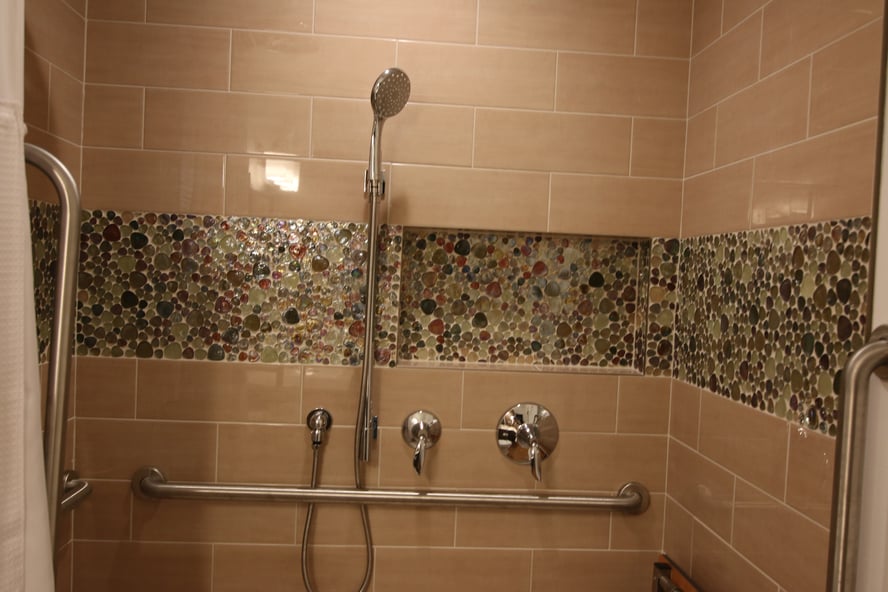
The services offered by a CAPS professional varies from a complete accessible remodel to improving certain areas in the home like bathrooms or kitchens. The precise modifications increase usability according to personal needs of the homeowner and family. The CAPS program connects responsible professionals with homeowners needing specialized accessibility services on an ever-increasing basis. Ordinary homeowners with extraordinary challenges partner up with experienced CAPS professionals and their own families. Working as a team, the trained CAPS specialist along with any family caretakers or therapists is able to identify the day-to-day problems weighing on those with health limitations. Aging in Place services provided by a specialized remodeling contractor ensures all accessibility issues of the home are accomplished correctly. T-Square Company located in Austin, Texas is one of the specialized CAPS certified contractors.
The CAPS credential is a nationwide initiative and many construction and design professionals are taking advantage of the helpful training across the nation. David L. Traut, president, and owner of T-Square Company is an active CAPS member (#1636580) and has participated in the program for over a decade. Furthermore, he has actively completed accessibility design/build remodels for over 25 years for the private sector, HUD, and the VA. Always check a person's credentials to verify the remodeler holds an active CAPS certification and is familiar with Universal Design. All registered CAPS program graduates and remodeling companies are listed in a national registry in Washington DC. The information is found by calling 1-800-368-5242 or by simply visiting their website at: http:www.nahb.org/en/learn/designations/certified-aging-in-place-specialist.aspx.

If the current pandemic taught us anything concerning safety and institutional living situations, we now know it is much safer to remain in your home surrounded by familiar surroundings and friends. During the stay-at-home mandates, everyone was aware of what Aging in Place meant. We all became better acquainted with our homes and family members. The best way to approach a desire to Age in Place is by being proactive before an illness takes control of your life. At that point, you must deal with it in a reactive manner. There are many differences between home modifications and a home remodel. The main difference is home modifications involve investing in your familiar home versus spending during remodeling. Home modifications are used to enhance your ADL (Activities of Daily Living) whereas remodeling deals more with aesthetics. Investing in your home will benefit your future retirement years by making your home conform to your needs.
T-Square Company in Austin, Texas is a CAPS certified remodeler and offers design/build Aging in Place projects using principles of Universal Design. Call 512-444-0097 to discuss your project today and learn how you can achieve better accessibility within your existing home. Our knowledge and experience can help solve your personal needs within your existing home. Whether you need a safer shower, wider doorways, a zero-step entrance, or a more accessible kitchen to entertain your family and friends, T-Square Company is here to help.
Tags:
barrier free access,
aging in place remodeling,
CAPS,
aging in place home modifications,
ADA compliance,
custom tub to shower conversions,
accessible home remodeling,
CAPS remodeling techniques,
aging in place services,
bathroom modifications for disabled,
ADA bathroom Austin, Texas,
home modifications for independent living Austin,
Austin Handicap Remodeling,
universal design ideas,
certified aging in place consultant in Austin,
universal design remodeling contractor,
handicap accessible remodeling,
barrier free remodeling,
disability remodeling,
handicap accessible bathroom shower,
veterans home remodeling in Austin, Texas,
veterans home accessibility help in Austin, Texas,
accessible toilets,
ADA Compliant grab bars,
home access,
what is aging in place,
accessible home builder in Austin,
ADA Compliant Bathroom Vanity,
the basics of aging in place,
universal design home additions
As a universal design/build construction company located in Austin, Texas, T-Square Company realizes that building for your future changing needs is a very valuable consideration concerning all your periodic remodeling projects. We always design for the future for our clients, regardless of their age or abilities. This thought process is especially true when designing a bathroom upgrade. Being a nationally CAPS certified remodeler, we are very aware your personal needs can change in the blink of an eye. The daily tasks of getting into the bathroom, bathing, showering, using the toilet, or brushing your teeth can become almost impossible without assistance if you don't address your bathroom's inaccessibility in a proactive manner. Any revisions must be completed before you absolutely need the help. Design shortcomings become ever so noticeable if you have an accident and are recovering at home or a debilitating disease sets in. Most all problems caused by architectural barriers will be eliminated with a handicap accessible bathroom remodel.
We are certain that avoiding emergency remodeling while incorporating Universal Design techniques into your home whenever possible is a great way of enhancing your health, independence, and safety. This practice also provides a better overall quality of life. The sooner the main inaccessible areas in your home are addressed, the longer you and your family have to enjoy them. For those desiring to Age in Place, as in safely living in your own home for as long as possible, gradually incorporating the principles of Universal Design into all remodeling projects provides a seamless gateway for successful aging. So, what are the main concerns when designing a bathroom for the future?
Getting Into The Bathroom
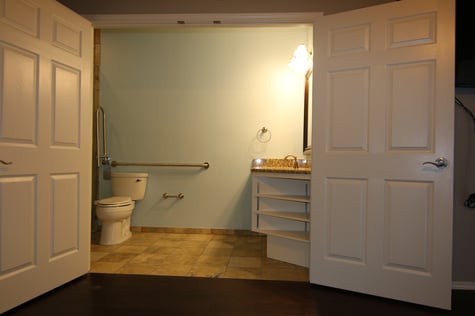
When possible, you should always install a 36-inch wide door into your bathroom allowing all mobility devices to enter without obstruction. Sometimes it's easier when walls cannot be altered or removed to make a large double door entry into the bathroom. Replacing the original twenty-four to twenty-eight-inch wide door offers maximum accessibility for anyone. This universal design element provides clear approaches toward all bathroom fixtures from an adjoining room. Additionally, an unobstructed 60-inch wheelchair turning radius is shared by the bathroom and adjacent room.
An Accessible Shower
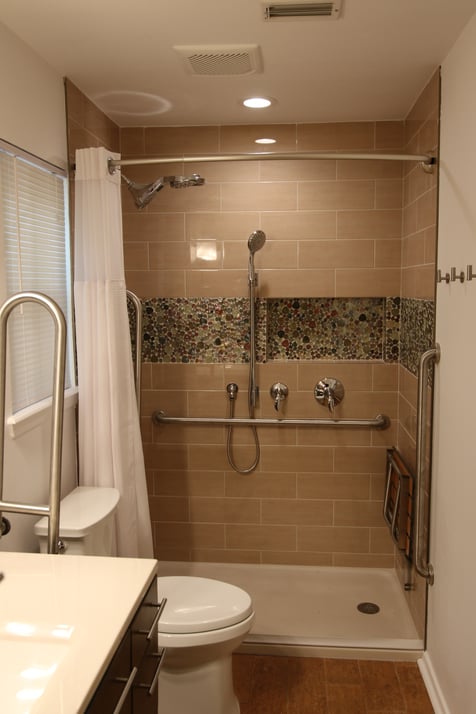
A safe, low-profile (1 1/2" tall) accessible shower with roll-in capability from an add-on ramp suits the needs of most diverse homeowners. Even if you don't require the grab bars during a particular phase of your life, installing adequate blocking before the tile is installed provides a universal path for your future needs once the bars are required. Take note, the grab bars must be able to withstand a shear force of 300 pounds. Their purpose is to provide support and stability when you need it most. Clutter within the shower and especially on the shower floor is a safety hazard. Recessed shampoo niches keep shampoo bottles and other items off the floor. Additionally, folding shower seats are far safer than free-standing models that are rarely ever in the right place. They save space when folded while not in use and never interrupt the use of a shower chair. It is a common misconception that shower controls must be mounted on one wall underneath the fixed shower head. Shower valves can be installed anywhere they are most convenient for the user, especially if a caretaker is involved. A recessed shower can light above the shower decreases shadows and further increases safety.
Using The Toilet
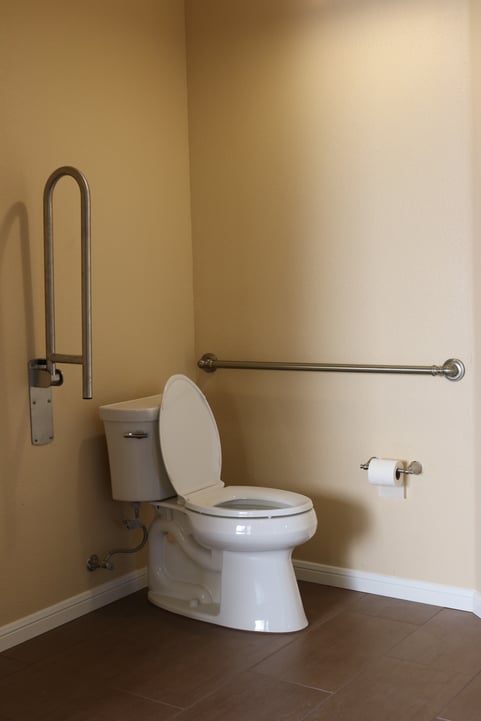
When a toilet exists in a confining room or space, there is no easy way of approaching it if you have mobility problems and especially if you are using any kind of mobility device. After all, safety is the predominant concern when using the toilet. Remove all restricting walls and narrow doors so everyone can freely approach and use the toilet. Once again, grab bars increase safety when they are required and must be adequately prepared for installation. Another problem with toilets involves those that are too short requiring deep knee bends for using them. A higher comfort height toilet offers significant help with this problem. Be sure the flush handle is toward the open side of the bathroom.
Brushing Your Teeth
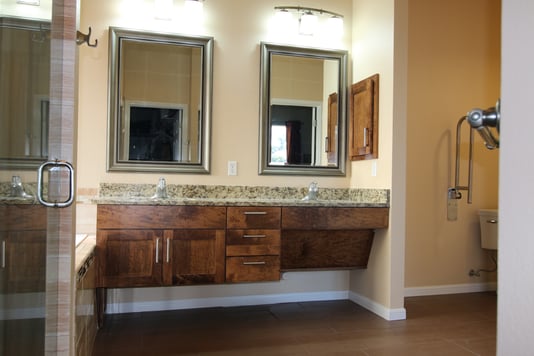
Offering adaptability in a vanity is a universal design aspect. Everyone has equal access while standing or using a wheelchair--if only for a short time during recoveries. More adaptability is offered using multiple height countertops. Lever faucets are easier for everyone to operate, even for those users with arthritis. Motion-sensor faucets create washing areas that are completely hand-free.
When you are ready to take the next steps toward your accessible future, contact T-Square Company in Austin, Texas. We can show you how to address your personal needs using our more than thirty years of knowledge and design/build accessibility experience. We guarantee to keep you safer in your existing home longer and out of dangerous and uncaring institutions using our proven design methods. We offer all handicap accessible home renovations or additions--especially accessible bathrooms.
David L. Traut, CAPS #1636580
Tags:
aging in place remodeling,
custom walk in showers,
certified aging in place specialist,
ADA bathroom Austin, Texas,
disability access bathrooms Austin,
Austin Handicap Remodeling,
universal design ideas,
universal design building for a lifetime,
home accessibility help in Austin,
universal design remodeling contractor,
7 principles of universal design,
applying principles of universal design in Austin,
handicap accessible remodeling,
barrier free remodeling,
disability remodeling,
handicap bathroom remodel,
ADA compliant wheelchair accessible showers,
disability access contractor,
veterans home accessibility help in Austin, Texas,
barrier free showers in Austin,
accessible bathroom design specifications,
ADA vanity in Austin,
accessible toilets,
what is an ADA compliant bathroom,
universal design/build contractor,
universal design vs. aging in place,
home accessibility,
accessible design,
why universal design,
what is aging in place,
accessibility home modifications,
handicap bathroom vanity,
handicap accessible floor plans,
maneuvering in and around the accessible home,
future home building using universal design,
universal design home additions
T- Square Company in Austin, Texas is an industry leading accessible, universal, certified Aging in Place and VA approved Specially Adapted Housing custom home builder and remodeler. We offer both new totally accessible homes and complete handicap modifications for existing homes. Traditional home builders and remodelers don't really consider the needs of the disabled or elderly like ADA vanities , roll in showers, or specially adapted kitchens which are universal in nature. It takes a special breed of contractor to realize special needs for special people.
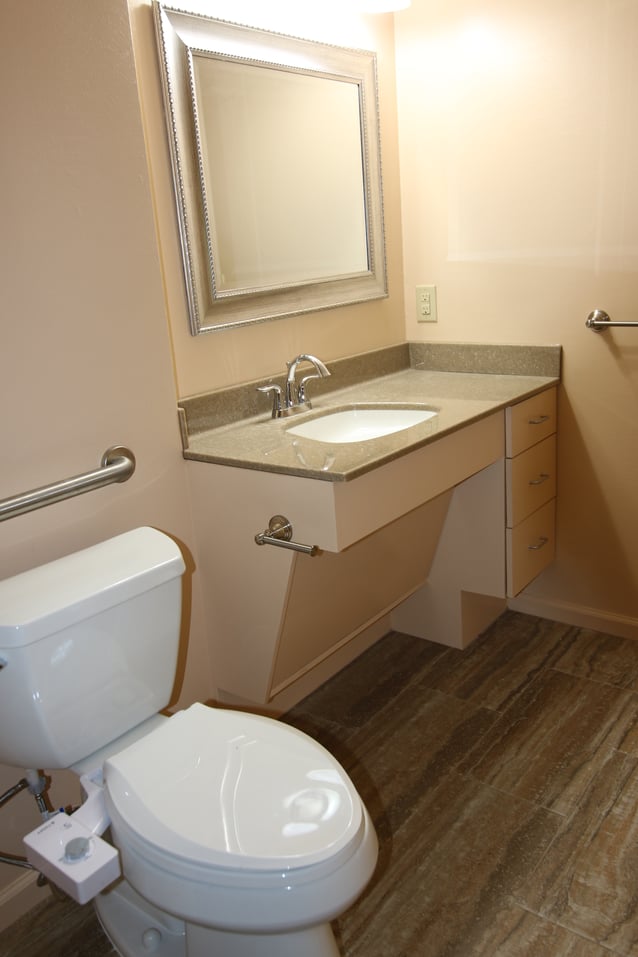
A revolution in building design standards is long overdue. Our current building design standards do not address the needs of more than one third of our existing population. Many more people can greatly benefit from accessible design versus conventional design. Our rapidly aging population is experiencing the limitations of our personal living environments. Any evolution in building practically always begins in the common areas of the commercial building sector. The American Disabilities Act of 1990 increased the attention needed for those people having the right to equally access their work place and any recreational or leisure facilities. These rules at least offer minimal solutions for those needing the most help with any building access. In Austin, we now must provide access to one bathroom on the first floor in new homes as deemed by our newly adopted building regulations. This basic right to a handicap accessible bathroom is finally being enforced by the city's building inspectors. What a tremendous needed and basic design improvement!
Finding the right design/build contractor with ADA knowledge and experience can be a challenge. Obtaining help for maintaining your independence throughout an accessible wheelchair design in Austin is possible. You should be looking for a CAPS certified contractor who understands life changes. A local contractor who offers specialty products and services standing out from the rest of the pack. A contractor who has the ability, through experience, to help clear the murky water impeding your accessible route and how it can be accomplished. One who takes ADA remodeling to another level promoting safety. A well versed construction professional can take on and solve any residential ADA challenge creating handicap accessible house plans. These can include widening doorways, ADA compliant kitchen cabinets, or ADA compatible baths.

Accessible floor plans can include level no step entries, wider hallways and doorways, adequate maneuvering space for a wheelchair turning radius throughout the home, non-slip flooring, ramps to overcome level changes, clear unobstructed walkways, special area lighting, accessible closets and storage, roll out or pull out shelving, easy grab door hardware, automatic and graspable faucets, full extension drawers, accessible switches and outlets, roll in showers, ADA roll under vanities, counter tops, and work spaces, accessible kitchen appliances, and many other specialty features designed around the homeowner's abilities.
A handicap accessible house plan takes the special needs of the physically disabled into consideration throughout the entire design. This type of home layout typically includes fewer walls, more open space, and wider hallways for increased mobility throughout the home for those that require the use of a wheelchair.
The Americans with Disabilities Act (ADA) ensures that public spaces are designed to accommodate disabled patrons, and this type of home does as well. After all, living with a disability presents many challenges, as the ADA acknowledges, and navigating the home shouldn't be one of them. The home shouldn't ever make the homeowner feel like a prisoner within it's walls.
Aging in place construction and Austin ADA remodeling has become synonymous with handicap accessible home design and modification during our lifetime. Home modifications can be used to accommodate anyone from people with mobility impairments to those with vision loss, hearing loss, or even cognitive or developmental disabilities. Accessibility home modifications or wheelchair accessible kitchen and bathroom remodeling in Austin will allow anyone with limited mobility within your home to feel more empowered and independent. The extent of a customized accessibility design is dependent upon the activity level of the person requiring the modifications.

Today's conventional building standards conflict with most people's accessibility when you consider our created architectural barriers concerning cabinetry and door opening widths, individual strength, range of motion, movement, manual dexterity, balance, and coordination. Once the demands of our built environment exceed their capacities we become excluded from a room or even the entire home. The building world must work in unison to be sure the entire living environment meets basic needs in addition to affordability and structural integrity for the consumer and home owner. This includes both the home and the components within the home being accessible to all inhabitants. Privacy, sense of belonging, sense of control, and the sense of safety and security make up the quality of life for any home and should be considered for any design increasing home accessibility.
Tags:
barrier free remodeling,
handicap remodeling,
disability remodeling,
handicap access bathroom remodel,
ADA compliant wheelchair accessible showers,
disability access contractor,
home modifications for Austin veterans,
veterans home accessibility help in Austin, Texas,
ADA compliant roll in showers,
wheelchair accessible shower stalls,
accessible bathroom design specifications,
specialty construction in Austin,
what is ada compliant,
home access,
accessible homes,
what is an ADA compliant bathroom,
home access in Austin,
bathroom remodeling contractors Austin, TX,
bathroom remodel contractors,
universal design/build contractor,
universal design vs. aging in place,
universal design contractor,
home accessibility,
accessible design,
why universal design,
what is universal design in Austin,
what is aging in place,
wheelchair accessible housing,
accessible housing,
handicap accessible housing,
handicap accessible house plans,
accessible homes in austin,
universal design techniques,
Austin home remodeling for disabled,
accessibility home modifications,
accessible home modifications,
wheelchair accessible bathroom,
handicap bathroom design,
handicap bathroom requirements,
handicap bathroom vanity,
modifying your home for a disabled child,
wheelchair access,
handicap bathroom contractor in Austin,
handicap accessible floor plans
When mobility becomes an issue for any homeowner, regardless of age, the question arises concerning physically moving to a different home with a bath that is more accessible. Preparing for one of those highly likely events involving someone in your home needing room modifications for even a short time while recovering from surgery is surely a smart move. Solving aging in place issues will soon become the number one challenge concerning the present obsolete housing inventory in our country. Our present day obsolete homes now inhabited by the baby boomer generation will slowly and increasingly raise their outdated and obsolete ugly heads and expose their true lack of kitchen or bathroom accessibility to those very people inhabiting them. The situation will only become ever more expanding in time. When these homes were previously purchased, they represented an absolute castle in the world of their owners in which to prepare for a day and they also acted as a retreat from life's tough interactions. They housed our families, our memories, and our stuff. They represented a place where we could be ourselves. Our homes have always been exempt from any and all of the accessibility regulations that have been put in place since 1968 when our Viet Nam veterans were returning home.
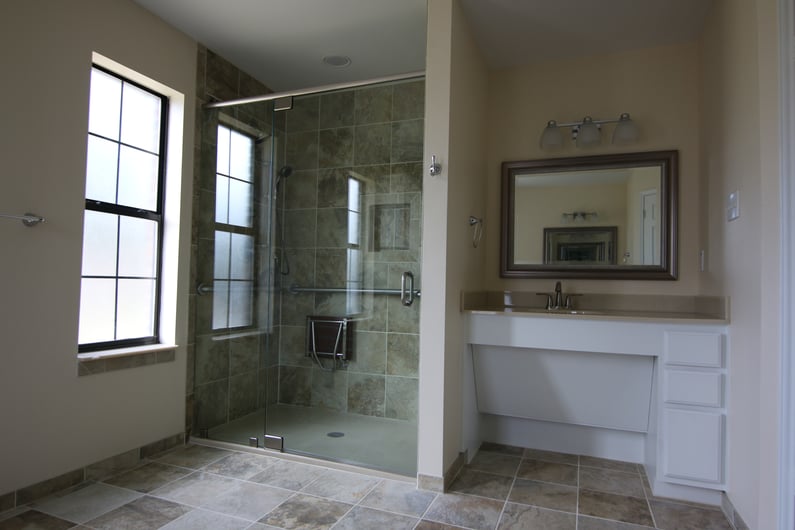
The new evolving concept known as Universal Design and specialized handicap remodeling contractors for home access remodeling is catching on nation wide and has been for several years as a sign of the times. Universal design techniques used in building makes a home more accessible to all regardless of their mobility or adaptive abilities. An evolution of new products used for disability home modifications is making those homes more accessible and has finally come about in the remodeling industry. These new advances in accessible home remodeling in Austin not only keep the living environments safer but will not compromise the home's aesthetics. In fact, there are many benefits to using universal design techniques, including potential use by aging family members, added resale value, and the fact that you'll be creating a space that can be used by anyone who visits your home, regardless of their range of abilities. Simple universal design updates for aging in place home modifications and handicap bathroom accessibility can include adding grab bars or handrails throughout the home, adding a seat within the roll in shower, lowering upper cabinets and counter tops, adding non-slip flooring, widening hallways or installing stair lifts, and widening doors. Many people find themselves needing accessible homes for themselves or family members. There are approximately 30 million Americans using wheelchairs and the number of people who need accessible homes will continue to increase as disabled and aging people are finding more ways to remain living in their homes. One important way to increase independent living is making a home accessible to an individuals personal needs. Home modifications can increase safety, accessibility, and independence for people who want to live independently.

The National Association of Home Builders, in partnership with the AARP and Home Innovation Research Labs, created the CAPS program, which includes training and education on the technical, business management and customer service skills essential to compete in the fastest growing segment of the residential remodeling industry--home modifications for aging in place and ADA accessibility in Austin, Texas. David L. Traut, CAPS the owner of T-Square Company in Austin, Texas is one of the select group of professionals nationwide to earn the Certified Aging-In-Place Specialist (CAPS) designation, identifying him as a home remodeler and builder with the skills and knowledge necessary to remodel or modify a home to meet the unique needs of the older population, disabled owners, or their visitors.
If you ever find yourself needing better accessibility within your home during a recuperation or as a general more permanent need please don't hesitate to reach out to me directly.
Sincerely,
David

Tags:
residential general contractor Austin, Texas,
home accessibility help in Austin,
home remodeling for disabled in Austin Texas,
wheelchair accessible home remodeling in Austin,
universal design remodeling contractor,
principles of universal design,
Austin Senior Home Remodeling,
disability contractor in Austin,
disability and special needs contractor Austin,
home modifications for elderly in Austin,
bathrooms with disability access in Austin, Texas,
Austin disability contractors for special needs,
Austin handicap bathroom contractor,
handicap accessible remodeling,
handicap remodeling,
handicap accessible home renovations,
disability remodeling,
handicap accessible bathroom remodel,
handicap accessible bathroom shower,
ADA compliant wheelchair accessible showers,
disability access contractor,
home modifications for Austin veterans,
veterans home accessibility help in Austin, Texas,
ADA compliant roll in showers,
wheelchair accessible shower stalls,
accessible bathroom design specifications,
accessible toilets,
barrier free toilets,
ADA vanity height,
ADA Compliant grab bars,
professional remodeling contractor,
professional remodeler,
disabled bathroom remodel,
accessible bathroom remodel,
specialty construction in Austin,
home remodeling contractor residential,
home access,
accessible homes,
what is an ADA compliant bathroom,
home access in Austin
ADA wheelchair ramp guidelines are as follows:
- The minimum ramp width must be 36 inches minimum but 48 inches is preferable.
- Ramps must have edge protection to keep anyone from slipping off their surface in the form of a raised outer curb or railing.
- All wheelchair ramps must have level or flat unobstructed landings at the top and bottom of the rise being overcome that are 60 inches by 60 inches to provide a proper five foot wheelchair turning radius. The landing areas cannot have more than a 30 feet long ramp separating them. If the rise distance requires longer than a 30 foot run to overcome it then a series of landings can be used creating a switchback design.
- Thirty six inch handrails are required on both sides of all ramps that rise steeper than 6 inches from the ground below.
- All surfaces must be slip resistant and stable.
A wheelchair ramp is basically an inclined plane installed in addition to or instead of stairs. Ramps provide wheelchair users or users of other mobility aids as well as people pushing strollers,carts, or other wheeled objects, better access to any building. When designing a wheelchair ramp, you need to consider the users physical limitations. The ramp should be wide enough to be safe and maneuverable and sturdy enough to carry the weight of an electric wheelchair and it's cargo (this can approach 6-700 pounds in many instances) and have a slope that is gradual enough for a manual wheelchair user to navigate.
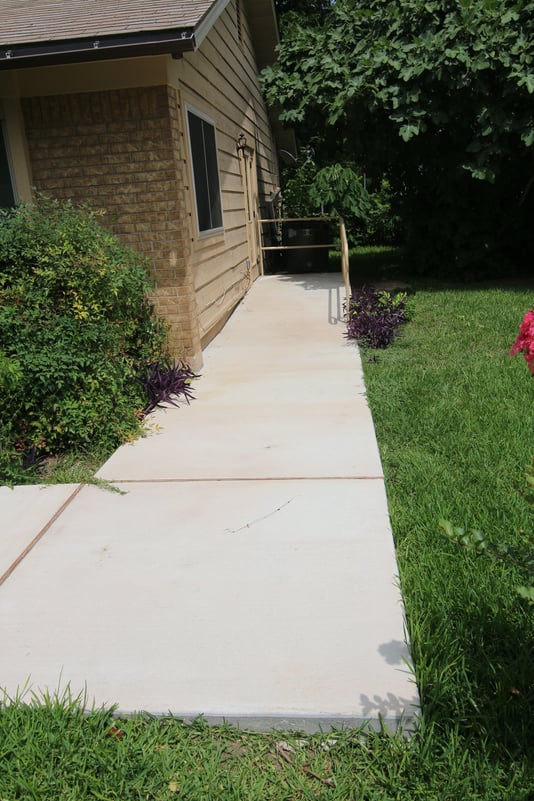
Let's say your front porch is 24 inches tall and you are needing easier access to your home while using a wheelchair or walker. A straight ADA prescribed 1:12 ramp will let you overcome the 24 inch porch rise over a span of 24 feet. This is as steep a ramp that is allowed but it may not work for everyone and it may need to be of less slope as in 1:16-1:20. However, if your porch is 36 inches tall, a maximum thirty feet long straight ramp will overcome only 30 inches of the rise of your porch and the remaining six inches can be overcome by an additional six feet long ramp which occurs only after a five feet by five feet flat turning area is installed. This is referred as a switchback and the additional six feet ramp can be added on any face of the flat area. It can be installed as a straight run or as a ninety degree turn in either direction. If adequate room isn't available for the above scenario, then the switchback can occur along the path of travel anywhere as long as the approaching ramp doesn't exceed thirty feet in length which is a maximum. Don't forget to include another flat 60" by 60" landing at the front door and at the end of the incline ramp to allow for greater maneuverability and door operation.

Upon entering the home, you can begin the accessible route which is designed to take you through the home to the most visited areas like the bathroom, kitchen, and living areas in that order. Our homes have always been exempt from any and all of the accessibility regulations that have been put in place since 1968 when our Viet Nam veterans were returning home. The new evolving concept known as Universal Design and specialized handicap remodeling contractors for home remodeling is catching on nation wide and has been for several years as a sign of the times. Universal design techniques used in building makes a home more accessible to all regardless of their mobility or adaptive abilities. An evolution of new products used for disability home modifications is making those homes more accessible and has finally come about in the remodeling industry.
The National Association of Home Builders, in partnership with the AARP and Home Innovation Research Labs, created the CAPS program, which includes training and education on the technical, business management and customer service skills essential to compete in the fastest growing segment of the residential remodeling industry--home modifications for aging in place and ADA accessibility in Austin, Texas. David L. Traut, CAPS the owner of T-Square Company in Austin, Texas is one of the select group of professionals nationwide to earn the Certified Aging-In-Place Specialist (CAPS) designation, identifying him as a home remodeler and builder with the skills and knowledge necessary to remodel or modify a home to meet the unique needs of the older population, disabled owners, or their visitors. Schedule an appointment by calling 512-444-0097 today.

Tags:
accessible routes,
barrier free access,
aging in place home modifications,
wheelchair accessible remodeling,
wheelchair accessible baths and kitchens,
handicap home modifications,
CAPS certified remodeling in Austin,
aging in place remodels,
handicap accessible bathrooms,
custom tub to shower conversions,
aging in place specialist,
disability home modifications in Austin,
Austin elder construction,
handicap home modifications for disabled,
home modifications Austin, Texas,
accessibility remodelers in Austin,
ADA bathroom Austin, Texas,
roll in showers,
roll in showers in Austin,
certified aging in place consultant in Austin,
senior aging in place services,
why is aging in place important,
what is universal design,
home remodeling for disabled,
remodeling companies in Austin TX,
wheelchair accessible home remodeling in Austin,
universal design remodeling techniques,
universal design remodeling contractor,
universal design principles,
remodeling for elders in Austin,
disability and special needs contractor Austin,
Austin disability contractors for special needs,
handicap remodeling,
handicap accessible home modifications,
roll in shower design for wheelchair access,
accessible home remodeling for disabilities,
veterans home accessibility help in Austin, Texas,
barrier free showers in Austin,
ADA compliant roll in showers,
handicap ADA roll in shower,
wheelchair accessible shower stalls,
professional remodeler,
specialty construction in Austin,
home remodeling contractor residential,
what is ada compliant,
home access,
accessible homes,
wheelchair ramp slope,
wheelchair ramp specifications,
ADA wheelchair ramp
A bathroom designed for someone who is aging in place is very different than one based on aesthetics or home value. Remodeling when considering future needs requires intuitive thought and considerations before you begin. The issues to consider include a safe design having ease of use by everyone and the people who will be using the facilities. Remember that remodeling a bathroom will take time and effort and there will be costs involved. When someone wants to age in place it is worthwhile to explore a universal design bathroom design that is both comfortable and safe to use as the occupant’s personal needs change. The bathroom is one space in the home where safety is of the utmost importance. From the toilet, to the shower, the vanity, and onto the lighting, there are adaptations and products to help keep the bathroom a safe place for all.
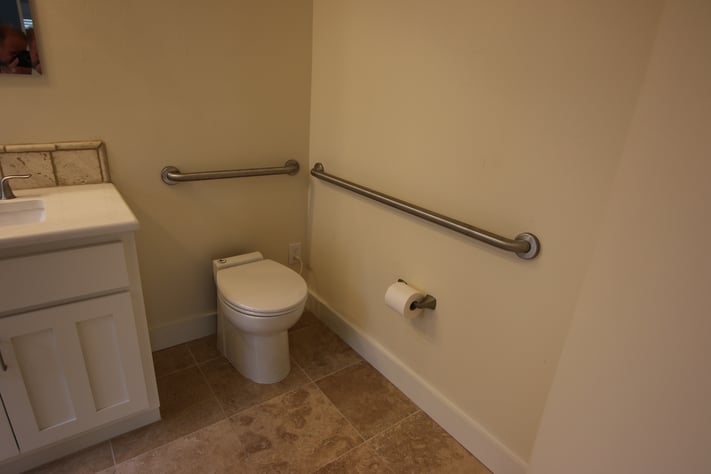
The goal of an accessible bathroom design is to make the bathroom a safe space for everyone who uses the facilities. Aging in place services use universal design to accommodate wheelchair use and can make the bathroom more comfortable for all generations with or without specific needs. It is important to carefully outline the scope of work during the remodeling of an accessible bathroom by first taking inventory of the users capabilities, needs, and preferences. All disability home remodeling or disability bath remodels must be done considering all the data provided by the client, his or her family, and any caretakers involved. Aging in place design must be carried out by an aging in place specialist holding a CAPS certificate. Only an experienced qualified remodeler holding a CAPS certificate has the qualifications to design an accessible route and perform the construction required to make it safe and functional for the AIP customer. Accessible bathrooms with custom walk in showers and kitchens are available using the right education and experience. Never consider hiring a "jack of all trades but master of none" type handyman to tear your bathroom apart. What's more, you certainly do not want to witness such a person struggling to piece the room back together attempting to achieve your long desired bathroom remodel idea. If so, you will absolutely learn a hard and invaluable lesson in getting what you pay for by accepting the handyman's cheapest bid.

In 1990, The Americans With Disability Act (ADA) set forth the guidelines for accessibility within public and commercial buildings. We use these same guidelines today when designing for people's increased accessibility within their home since no laws exist for the residential marketplace. Most of the requirements are merely common sense when universal design techniques are practiced. For instance, the standards for toilets regulate the height, the clearance in front and to the sides, the positions of grab bars and toilet paper holders, and the operation of the flush mechanism.
The height of a standard toilet is 17 inches or lower with 14 1/2 inches being the common height. The ADA guidelines mandate a distance between 17 and 19 inches from top of the seat to the floor on a handicap toilet. If the toilet is for use by children the height must be between 11 to 17 inches. The flush control is required to be on the open side of the toilet and should have easy one hand operation.
If you're designing a bathroom for handicapped use, implementing ADA standards within the design make it easier for wheelchair bound people to maneuver around the toilet. Consider the placement of the toilet in relation to walls and barriers in the bathroom. Having a clear floor space with at least 48 inches between the walls on either side of the toilet to make it easier to negotiate the approach. The toilet should be positioned a distance of 18 inches from one of the walls to create an approach space on the opposite side of the toilet. If the lavatory is situated on a side wall it must be placed at least 18 inches from the toilet. Space requirements in front of an ADA toilet vary according to the placement of the toilet, but in general, you need about 66 inches from the back wall to the wall opposite the toilet which is almost standard in a bathroom dictated by the width of a standard tub. A clear five foot turning radius should be observed for maximizing wheelchair operations. Grab bars are required in all ADA compliant bathrooms or toilet stalls. You should provide them behind the toilet and on the side walls and they should be 33 to 36 inches above the finished floor. The grab bar lengths should be twenty four to thirty six inches behind toilet and forty two to forty eight inches on the side wall with the bar located two feet from the front of the toilet. Folding grab bars can be used when the side wall isn't sufficient and they fold up for convenient out of the way storage.

Tags:
applying principles of universal design in Austin,
home remodeling for seniors Austin,
Austin Senior Home Remodeling,
remodeling for elders in Austin,
home remodeling for the elderly,
disability contractor in Austin,
special needs contractor in Austin,
disability and special needs contractor Austin,
senior home modifications in Austin,
home modifications for elderly in Austin,
bathrooms with disability access in Austin, Texas,
Austin disability contractors for special needs,
Austin handicap bathroom contractor,
handicap accessible remodeling,
barrier free remodeling,
handicap remodeling,
handicap accessible home modifications,
handicap accessible bathroom remodel,
handicap bathroom remodel,
disability access contractor,
accessible home remodeling for disabilities,
home modifications for Austin veterans,
veterans home remodeling in Austin, Texas,
veterans home accessibility help in Austin, Texas,
barrier free showers in Austin,
accessible bathroom design specifications,
accessible toilets,
wheelchair accessible toilets,
barrier free toilets,
handicap accessible toilets,
ADA Compliant grab bars,
ADA compliant grab bar height
No matter how old you are you should periodically evaluate your residence to determine whether it suits you not just for the present but the future. Your home assessments will be rethought every time your living situation changes. Whether childproofing for a newborn, making a home more accessible following a sickness or unfortunate accident to someone in the family, or making a toilet area safer for an aging residing parent, there will be an immediate evolution to your primary domicile. These same life span design features are even more important if you believe you're past the age of wanting to move and are relishing the thought of aging in your own home, no matter what physical limitations you might later develop. Incorporating smart aging design concepts into a home will attract a larger group of buyers when you decide to finally sell your home.
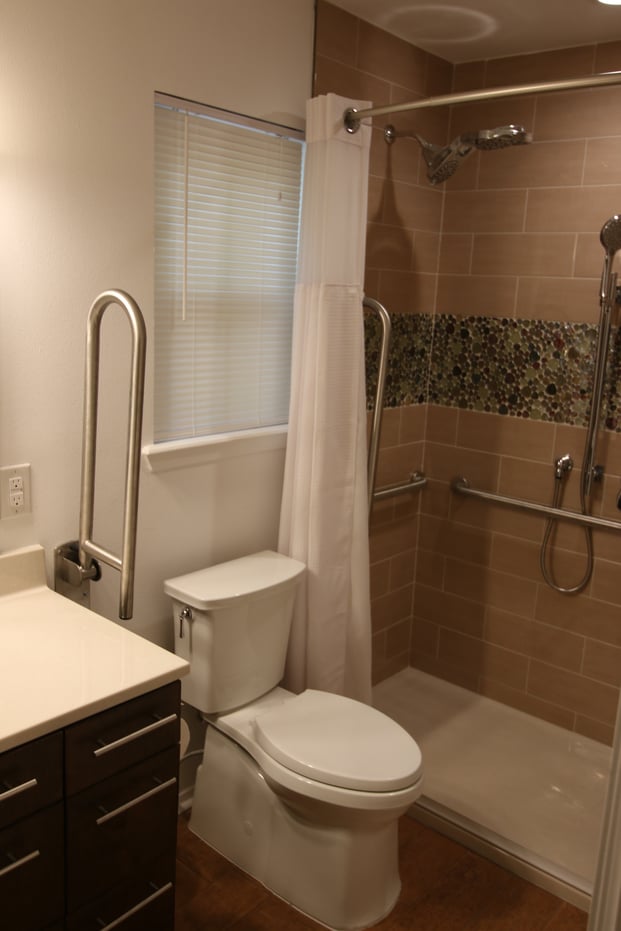
When mobility becomes an issue for any homeowner, regardless of age, the question arises concerning physically moving to a different home with a bath that is more accessible or making the existing home modifications which will meet the need of the new life changes.Solving aging in place issues will soon become the number one challenge concerning the present obsolete housing inventory in our country. Our present day obsolete homes now inhabited by the baby boomer generation will slowly and increasingly raise their outdated and obsolete ugly heads and expose their true lack of kitchen or bathroom accessibility to those very people inhabiting them. The situation will only become ever more expanding in time. When these homes were previously purchased, they represented an absolute castle in the world of their owners in which to prepare for a day and they also acted as a retreat from life's tough interactions. They housed our families, our memories, and our stuff. They represented a place where we could be ourselves. Our homes have always been exempt from any and all of the accessibility regulations that have been put in place since 1968 when our Viet Nam veterans were returning home. The new evolving concept known as Universal Design and specialized handicap remodeling contractors for home remodeling is catching on nationwide and has been for several years as a sign of the times. Universal design techniques used in building makes a home more accessible to all regardless of their mobility or adaptive abilities.
Many people find themselves needing accessible homes for themselves or family members. There are approximately 30 million Americans using wheelchairs and the number of people who need accessible homes will continue to increase as disabled and aging people are finding more ways to remain living in their homes. One important way to increase independent living is making a home accessible to an individual’s personal needs. Home modifications making homes wheelchair accessible can increase safety, accessibility, and independence for people who want to live independently.

Falls and slips are among the most common causes of injury to senior or elderly people and for those with a disability. Smooth surfaces in combination with wet areas make the bathroom one of the most dangerous areas within the home. It is of paramount importance that the bathroom be updated providing safety for any person with limited mobility or the elderly. Grab bar installation will greatly improve safety and usability of the bathroom.
If the residence is fairly new and uses universal design techniques or the geographic area uses accessible housing standards, the walls in the tub area and the walls behind and next to the toilet should have extra blocking. Blocking is a structural reinforcement within a wall that allows a grab bar to be attached securely to withstand a 250 pound force. Studs can also be used but may not be located in the most desirable location for the length of the grab bar being used. The purpose of a grab bar is to help support a person, and the grab bar must be able to support a person's weight until help arrives or the person can right themselves. A grab bar is both pulled and pushed against.The standard size for a grab bar is 1-1/4 to 1-1/2 inches in diameter and should be 1-1/2 inches away from the wall. With some new construction, blocking is placed in the walls such that grab bars can be installed easily at a later date when needed. If there is no blocking in the walls, it can be added later but the wall must be open up to expose the studs. The recommended type is 3/4 inch plywood, 6 to 12 inches wide and nailed into the studs or a 2 by 6 or 8 inch block nailed into the studs. Today, grab bars come in many metal finishes and decorative shapes. Contrasting colors are easier to see in an emergency. Grab bars with a slight milled in texture are easier to grip. The blocking should be the full length of the tub and at both ends. This allows grab bars to be installed anywhere in the area or in more than one place. Never install grab bars on an angle where wet hands can slip. Grab bars should exist on all sides of the shower and tub walls. At the toilet, the blocked areas should be behind the toilet and on at least one side. If there is no wall next to the toilet, an L-shaped grab bar can be installed by attaching the front end to the floor and the back to the wall behind the toilet. All grab bars should be installed at the universal height of 34-36 inches above the finished floor. Folding grab bars can be used when adjacent walls don't exist in a 24" reach distance for a seated person.

Once the demands of our built environment exceed their capacities we become excluded from a room or even the entire home. The building world must work in unison to be sure the entire living environment meets basic needs in addition to affordability and structural integrity for the consumer and home owner. This includes both the home and the components within the home being accessible to all inhabitants. Privacy, sense of belonging, sense of control, and the sense of safety and security make up the quality of life for any home and should be considered for any design. Universal Design is where we are headed out of necessity.
Tags:
age in place home design,
what does it mean to age in place,
universal designbuilding for the future,
residential general contractor Austin, Texas,
home accessibility help in Austin,
home remodeling for disabled in Austin Texas,
wheelchair accessible home remodeling in Austin,
universal design remodeling contractor,
universal principles of design,
applying principles of universal design in Austin,
remodeling for elders in Austin,
disability contractor in Austin,
special needs contractor in Austin,
disability and special needs contractor Austin,
senior home modifications in Austin,
home modifications for elderly in Austin,
bathrooms with disability access in Austin, Texas,
Austin disability contractors for special needs,
Austin handicap bathroom contractor,
handicap accessible remodeling,
barrier free remodeling,
handicap remodeling,
handicap accessible bathroom remodeling,
handicap accessible home renovations,
handicap accessible home modifications,
disability remodeling,
handicap accessible bathroom remodel,
Austin aging in place specialist,
handicap access bathroom remodel,
handicap accessible bathroom shower,
handicap bathroom remodel,
ADA compliant wheelchair accessible showers,
roll in shower design for wheelchair access,
disability access contractor,
accessible home remodeling for disabilities,
home modifications for Austin veterans,
veterans home remodeling in Austin, Texas,
veterans home accessibility help in Austin, Texas,
barrier free showers in Austin,
ADA compliant roll in showers,
handicap ADA roll in shower,
wheelchair accessible shower stalls,
roll in shower,
accessible bathroom design specifications,
wheelchair accessible toilets,
handicap accessible toilets,
ADA Compliant grab bars,
ADA compliant grab bar height


























